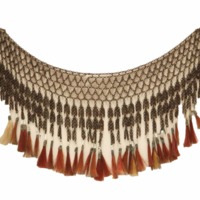Wooden Shield ("Kalasag" Bagobo Shield)
Text
Share this
Media
Images
Map National Anthropology Museum Madrid
Metadata
Identifier
CE1645
Origin
Bagobo (Mindanao, The Philippines)
Materials
Wood, hair, Manila hemp, brass, pitch
Physical Dimensions
w44 x h109 cm
Provenance
Brought over for the Exhibition on the Philippines, Mariana Islands, and Caroline Islands which took place in Madrid in 1887.
Acquisition Date
1887
Short description
These types of oblong shields were used by the so-called pagan groups in the Philippines and were usually adorned with inlaid seashells or engrained with black geometric patterns. The edges and, as in this case, the central boss, were decorated with the human hair of the Bagobo's dead enemies.
These carved motifs may also be found on other objects made by this group, such as various bamboo containers, clothes, and musical instruments. These objects are a symbolic representation of their world: the community is shown in an abstract image of its members joined by their hands and feet; and their dwellings, animals, the lightning, clouds, sun, moon, and stars, all of which formed an important part of their animist beliefs.
This exemplary piece was part of the Philippines General Exhibition, which took place in Parque del Retiro in Madrid, 1887.
These carved motifs may also be found on other objects made by this group, such as various bamboo containers, clothes, and musical instruments. These objects are a symbolic representation of their world: the community is shown in an abstract image of its members joined by their hands and feet; and their dwellings, animals, the lightning, clouds, sun, moon, and stars, all of which formed an important part of their animist beliefs.
This exemplary piece was part of the Philippines General Exhibition, which took place in Parque del Retiro in Madrid, 1887.
Display status
On Display
Acknowledgements
http://ceres.mcu.es/pages/Main?idt=21828&inventary=CE1645&table=FMUS&museum=MNA
Official Website
Collection
Cite this Page
“Wooden Shield ("Kalasag" Bagobo Shield),” Mapping Philippine Material Culture, accessed April 26, 2024, https://philippinestudies.uk/mapping/items/show/2538.
Geolocation
Sensitive Content
Mapping Philippine Material Culture collates digital material from institutions, and some of this material is inherently colonial and contains words, terms and phrases that are inaccurate, derogatory and harmful towards Filipino and Filipino diasporic communities. Catalogue transcriptions, book titles, exhibition titles and museum titles may contain harmful terms. We recognise the potential for the material to cause physical and mental distress as well as evoke strong emotions. Owing to the scale of the collection’s data, a process to implement sensitive-content warnings in the displayed data is still incomplete. The material within the catalogue does not represent Mapping Philippine Material Culture’s views. Mapping Philippine Material Culture maintains a strong anti-colonial, anti-racist position and affirms its support for centring the humanity of historically marginalised and disenfranchised communities.
Facebook Twitter



